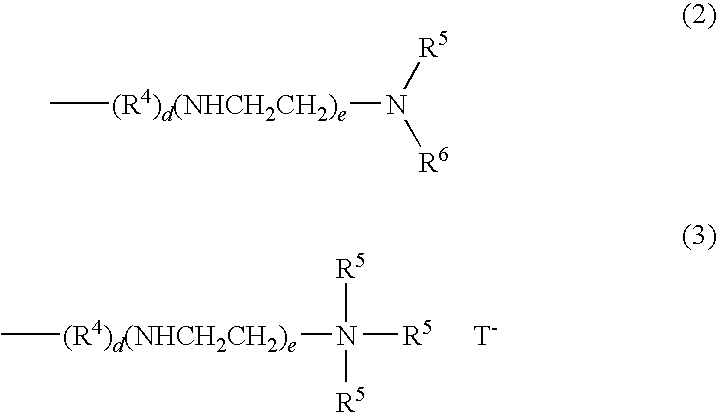Silicone-modified water-absorbing polymer particles and method for producing the same
a technology of water-absorbing polymer and modified silica, which is applied in the direction of synthetic resin layered products, natural mineral layered products, disinfection, etc., can solve the problems of water-absorbing polymer sticking problems and the inability of surfactant to be stably present on the surface of water-absorbing resin
- Summary
- Abstract
- Description
- Claims
- Application Information
AI Technical Summary
Benefits of technology
Problems solved by technology
Method used
Image
Examples
example 1
[0131]300 g methacrylic acid (Mitsubishi Rayon Co., Ltd.) and 135 g deionized water were placed in a 3-L beaker and then neutralized to a degree of 75% by adding 348 g of 30 weight % aqueous sodium hydroxide solution dropwise thereto under cooling with stirring, and then a solution of 1.2 g potassium persulfate (0.4% by weight relative to methacrylic acid) dissolved in 24.3 g deionized water and 15.0 g of a crosslinking agent ethylene glycol diglycidyl ether (trade name, Denacol EX810, Nagase Kasei Co., Ltd.) (5.0% by weight relative to methacrylic acid) were added thereto, and the mixture was uniformly dissolved. The resultant solution was added to a solution obtained by dissolving 15 g amino-modified silicone A (XF42-703 produced by Toshiba Silicones; viscosity (25° C.), 1000 mm2 / s; amine equivalent, 1500 g / mol) in 1500 ml cyclohexane in a 3-L beaker, and the mixture was stirred vigorously for 5 minutes at a number of revolutions of 10000 rpm in a homomixer to produce a fine water...
examples 2 to 5
[0132]Using the monomers, dispersants and crosslinking agents in Table 1, fine polymer particles were obtained according to the method in Example 1.
example 6
[0133]300 g methacrylic acid (Mitsubishi Rayon Co., Ltd.) and 135 g deionized water were placed in a 3-L beaker and then neutralized to a degree of 75% by adding 348 g of 30 weight % aqueous sodium hydroxide solution dropwise thereto under cooling with stirring, and then a solution of 1.2 g potassium persulfate (0.4% by weight relative to methacrylic acid) dissolved in 24.3 g deionized water was added thereto, and the mixture was dissolved uniformly. The resultant solution was added to a solution obtained by dissolving 15 g amino-modified silicone A (viscosity (25 C), 1000 mm2 / s; amine equivalent, 1500 g / mol) in 1500 ml cyclohexane in a 3-L beaker, and the mixture was stirred vigorously for 5 minutes at a number of revolutions of 10000 rpm in a homomixer to produce a fine water-in-oil droplet dispersion. Then, 900 ml cyclohexane was introduced into a 5-L stainless steel reaction vessel equipped with a reflux condenser, and stirred at 350 rpm and heated at 75° C. in the system, and t...
PUM
| Property | Measurement | Unit |
|---|---|---|
| particle size | aaaaa | aaaaa |
| particle diameter | aaaaa | aaaaa |
| particle diameter | aaaaa | aaaaa |
Abstract
Description
Claims
Application Information
 Login to View More
Login to View More - R&D
- Intellectual Property
- Life Sciences
- Materials
- Tech Scout
- Unparalleled Data Quality
- Higher Quality Content
- 60% Fewer Hallucinations
Browse by: Latest US Patents, China's latest patents, Technical Efficacy Thesaurus, Application Domain, Technology Topic, Popular Technical Reports.
© 2025 PatSnap. All rights reserved.Legal|Privacy policy|Modern Slavery Act Transparency Statement|Sitemap|About US| Contact US: help@patsnap.com



